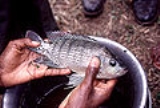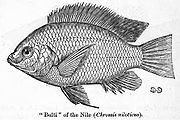
Oreochromis niloticus
Encyclopedia
The Nile Tilapia, Oreochromis niloticus is a relatively large cichlid
Cichlid
Cichlids are fishes from the family Cichlidae in the order Perciformes. Cichlids are members of a group known as the Labroidei along with the wrasses , damselfish , and surfperches . This family is both large and diverse. At least 1,300 species have been scientifically described, making it one of...
fish, which is native to Africa
Africa
Africa is the world's second largest and second most populous continent, after Asia. At about 30.2 million km² including adjacent islands, it covers 6% of the Earth's total surface area and 20.4% of the total land area...
from Egypt
Egypt
Egypt , officially the Arab Republic of Egypt, Arabic: , is a country mainly in North Africa, with the Sinai Peninsula forming a land bridge in Southwest Asia. Egypt is thus a transcontinental country, and a major power in Africa, the Mediterranean Basin, the Middle East and the Muslim world...
south to East
East Africa
East Africa or Eastern Africa is the easterly region of the African continent, variably defined by geography or geopolitics. In the UN scheme of geographic regions, 19 territories constitute Eastern Africa:...
and Central Africa
Central Africa
Central Africa is a core region of the African continent which includes Burundi, the Central African Republic, Chad, the Democratic Republic of the Congo, and Rwanda....
, and as far west as Gambia. It is also native to Israel
Israel
The State of Israel is a parliamentary republic located in the Middle East, along the eastern shore of the Mediterranean Sea...
, and numerous introduced
Introduced species
An introduced species — or neozoon, alien, exotic, non-indigenous, or non-native species, or simply an introduction, is a species living outside its indigenous or native distributional range, and has arrived in an ecosystem or plant community by human activity, either deliberate or accidental...
populations exist outside its natural range.
It is also commercially known as Mango fish or Nilotica. The first name leads to easy confusion with another tilapia that is traded commercially, the Mango tilapia
Mango tilapia
The mango tilapia is a species of fish from the cichlid family. The nominate subspecies is a relatively large cichlid at up to in length and about in weight, but its remaining subspecies are not known to surpass in length.The widespread nominate subspecies is found in lakes, rivers and other...
(Sarotherodon galilaeus).
Description
Variously reported in the literature to be a planktonPlankton
Plankton are any drifting organisms that inhabit the pelagic zone of oceans, seas, or bodies of fresh water. That is, plankton are defined by their ecological niche rather than phylogenetic or taxonomic classification...
feeder, an omnivore
Omnivore
Omnivores are species that eat both plants and animals as their primary food source...
, and to feed on higher plants to the extent that it may be used in control of aquatic weeds.
Introduced tilapia
Tilapia
Tilapia , is the common name for nearly a hundred species of cichlid fish from the tilapiine cichlid tribe. Tilapia inhabit a variety of fresh water habitats, including shallow streams, ponds, rivers and lakes. Historically, they have been of major importance in artisan fishing in Africa and the...
s can, on the other hand, easily become an invasive species
Invasive species
"Invasive species", or invasive exotics, is a nomenclature term and categorization phrase used for flora and fauna, and for specific restoration-preservation processes in native habitats, with several definitions....
(see Tilapia as exotic species
Tilapia as exotic species
A number of tilapiine cichlids that are native to Africa and the Levant have been widely introduced into tropical fresh and brackish waters around the world. In some cases, the introductions were deliberate, for example to control invasive aquatic plants, as in the U.S. states of Florida and Texas...
).
It is a species of high economic value and is widely introduced outside its natural range; probably next to the Mozambique tilapia
Oreochromis mossambicus
The Mozambique tilapia, Oreochromis mossambicus, is a tilapiine cichlid fish native to southern Africa. It is a popular fish for aquaculture...
(O. mossambicus) it is the most commonly cultured cichlid.
Aquaculture
Aquaculture of the Nile tilapia goes back to Ancient EgyptAncient Egypt
Ancient Egypt was an ancient civilization of Northeastern Africa, concentrated along the lower reaches of the Nile River in what is now the modern country of Egypt. Egyptian civilization coalesced around 3150 BC with the political unification of Upper and Lower Egypt under the first pharaoh...
, where it was called ỉn.t and represented by hieroglyph K1 of the Gardiner List
Gardiner's Sign List
Gardiner's Sign List is a list of common Egyptian hieroglyphs compiled by Sir Alan Gardiner. It is considered a standard reference in the study of Ancient Egyptian hieroglyphs....
. As a logogram
Logogram
A logogram, or logograph, is a grapheme which represents a word or a morpheme . This stands in contrast to phonograms, which represent phonemes or combinations of phonemes, and determinatives, which mark semantic categories.Logograms are often commonly known also as "ideograms"...
, this meant "a Nile tilapia". Used as a determinative
Determinative
A determinative, also known as a taxogram or semagram, is an ideogram used to mark semantic categories of words in logographic scripts which helps to disambiguate interpretation. They have no direct counterpart in spoken language, though they may derive historically from glyphs for real words, and...
(ideogram), it apparently signified Nile tilapia and/or flathead mullet
Flathead mullet
The flathead mullet, Mugil cephalus, is a mullet of the genus Mugil, found in coastal tropical and subtropical waters worldwide. Its length is typically 30 to 75 centimeters...
s which like the tilapia were commercially important fish, namely in the Nile delta:
If used as part of a phonogram, it represented the sound ỉn:
In modern aquaculture
Aquaculture
Aquaculture, also known as aquafarming, is the farming of aquatic organisms such as fish, crustaceans, molluscs and aquatic plants. Aquaculture involves cultivating freshwater and saltwater populations under controlled conditions, and can be contrasted with commercial fishing, which is the...
, wild-type Nile tilapia are not too often seen, as their flesh has a dark color that is not much desired by many customers, and because it has a bit of a reputation of being a trash fish associated with poverty. On the other hand, they are fast-growing and give good fillet
Fillet (cut)
A fillet is a cut or slice of boneless meat or fish.- Meat :In the case of beef, in the USA, the term most often refers to beef tenderloin, especially filet mignon.- Chicken :...
s; leucistic
Leucistic
Leucism is a condition characterized by reduced pigmentation in animals and humans. Unlike albinism, it is caused by a reduction in all types of skin pigment, not just melanin.- Details :...
("Red") breeds which have lighter meat have been developed and these are very popular.
Hybrid stock is also used in aquaculture; Nile × Blue Tilapia hybrids are usually rather dark, but a light-colored hybrid breed known as "Rocky Mountain White" tilapia is often grown due to its very light flesh and tolerance of low temperatures.http://www.miami-aquaculture.com/tilapia.htm
The Nile Tilapia has recently been discovered in a small stream in central Arkansas. This invasive species may harm the other aquatic life present in this stream within the next few years, depending on how quickly it is able to reproduce and how adapted it is to competition with other aquatic vertebrates. As of yet, there is evidence to support the possibility that the Nile Tilapia has established a strong breeding ground and will eventually endanger other fish species, possibly competitively exclude them.
Gastronomy
The red-hybrid Oreochromis niloticus is known in Thai languageThai language
Thai , also known as Central Thai and Siamese, is the national and official language of Thailand and the native language of the Thai people, Thailand's dominant ethnic group. Thai is a member of the Tai group of the Tai–Kadai language family. Historical linguists have been unable to definitively...
as Pla Thapthim , meaning "pomegranate
Pomegranate
The pomegranate , Punica granatum, is a fruit-bearing deciduous shrub or small tree growing between five and eight meters tall.Native to the area of modern day Iran, the pomegranate has been cultivated in the Caucasus since ancient times. From there it spread to Asian areas such as the Caucasus as...
fish". This type of Tilapia is very popular in Thai cuisine where it is prepared in a variety of ways.
The white tilapia Pla nin , meaning "Nile fish", is commonly either salted and barbecued or steamed with lime (pla nin nueng manao).
Systematics

- Baringo tilapia, Oreochromis niloticus baringoensis Trewavas, 1983
- Oreochromis niloticus cancellatus (Nichols, 1923)
- Oreochromis niloticus eduardianus (Boulenger, 1912)
- Oreochromis niloticus filoa Trewavas, 1983
- Oreochromis niloticus niloticus (Linnaeus, 1758)
- Oreochromis niloticus sugutae Trewavas, 1983
- Oreochromis niloticus tana Seyoum & Kornfield, 1992
- Oreochromis niloticus vulcani (Trewavas, 1933)
The forms referred to as Oreochromis (or Tilapia) "Nyabikere" and "Kabagole" seem to belong to this species too. An undescribed population found at, for example, Wami River
Wami River
The Wami River lies entirely within the African nation of Tanzania in the Pwani Region and Morogoro Region in eastern Tanzania. Its source is specified in the Kaguru Mountains and it flows East entering the Indian Ocean west of Zanzibar. But its catchment area extends from the Kinyasangwe River to...
, Lake Manyara
Lake Manyara
Lake Manyara is a shallow lake in the Natron-Manyara-Balangida branch of the Great Rift Valley in Tanzania. Said by Ernest Hemingway to be the "loveliest [lake] .....
and Tingaylanda seems to be a close relative.(Nagl et al. 2001)
Medical significance
In a recent research in KenyaKenya
Kenya , officially known as the Republic of Kenya, is a country in East Africa that lies on the equator, with the Indian Ocean to its south-east...
, it has been suggested that as this fish can feed on mosquito
Mosquito
Mosquitoes are members of a family of nematocerid flies: the Culicidae . The word Mosquito is from the Spanish and Portuguese for little fly...
larvae, it could be used in the fight against malaria
Malaria
Malaria is a mosquito-borne infectious disease of humans and other animals caused by eukaryotic protists of the genus Plasmodium. The disease results from the multiplication of Plasmodium parasites within red blood cells, causing symptoms that typically include fever and headache, in severe cases...
in Africa
Africa
Africa is the world's second largest and second most populous continent, after Asia. At about 30.2 million km² including adjacent islands, it covers 6% of the Earth's total surface area and 20.4% of the total land area...
.
See also
- Nile perchNile perchThe Nile perch is a species of freshwaterfish in family Latidae of order Perciformes. It is widespread throughout muchof the Afrotropic ecozone, being native to the Congo, Nile, Senegal, Niger, and Lake Chad, Volta, Lake Turkana and other river basins. It also occurs in the brackish waters of...
- a different fish, more common today as "Victoria perch". Both this fish and the Nile tilapia belong to the PerciformesPerciformesThe Perciformes, also called the Percomorphi or Acanthopteri, is one of the largest orders of vertebrates, containing about 40% of all bony fish. Perciformes means perch-like. They belong to the class of ray-finned fish and comprise over 7,000 species found in almost all aquatic environments...
, or perch-like fish.

